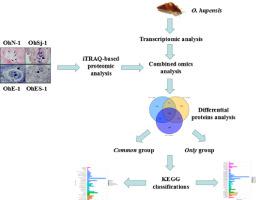Acta Tropica ( IF 2.1 ) Pub Date : 2020-07-06 , DOI: 10.1016/j.actatropica.2020.105623 Peng Li 1 , Theerakamol Pengsakul 2 , Yunlong Li 1 , Tianyichen Xiao 1 , Zhiming Su 1 , Haixia Ren 1 , Wenfeng Peng 3 , Mingke Lu 3 , Tianwei Lin 1 , Shuaiqin Huang 4

|
Oncomelania hupensis is the obligate intermediate host of Schistosoma japonicum, and it also serves as the first intermediate host for Exorchis sp., which uses Parasilurus asoyus as its definitive host rather than humans. In previous studies, Tang et al. found that all S. japonicum larvae can be blocked and killed in O. hupensis pre-infected with Exorchis sp. eggs. However, the molecular and cellular mechanisms involved in this process remain unclear. Therefore, in the present study, a combined transcriptomic and proteomic analysis was performed to identify the differential proteins involved in the immune response to the parasite S. japonicum in the O. hupensis snail host pre-infected with Exorchis sp. trematodes. The results showed that a total of 46,162 unigenes were obtained with 23,535 (50.98%) unigenes annotated in relevant databases, and 3811 proteins from O. hupensis were identified. In addition, iTRAQ-based quantitative proteomic analysis demonstrated that among three groups (OhSj-1_vs_OhN-1, OhE-1_vs_OhN-1 and OhES-1_vs_OhN-1), there were 146 common differential proteins including 44 up-regulated proteins and 90 down-regulated proteins, and 195 differential proteins exclusive to only one experimental group, including 91 up-regulated proteins and 104 down-regulated proteins, which were defined as the Common group and the Only group, respectively. KEGG analysis showed that 15 and 11 differential proteins were annotated in “Infectious diseases” in the Common group and the Only group, respectively, indicating that these proteins may be involved in the snail host immune response to parasite infection. These data will be helpful for better understanding the host-parasite interaction, and could pave the way towards exploring the mechanisms involved in the biological control on S. japonicum in O. hupensis. They also provide valuable information about developing new anti-schistosomiasis strategies.
中文翻译:

结合转录组学和蛋白质组学,以鉴定与预先感染了exorchis sp的蜗牛宿主对日本血吸虫的免疫应答有关的差异蛋白。
钉螺是日本血吸虫的专性中间寄主,它也是Exorchis sp。的第一个中间寄主,该寄主使用的是拟南芥,而不是人类。在先前的研究中,Tang等。发现在用Exorchis sp。预先感染的O. hupensis中,所有日本血吸虫幼虫都可以被阻断并杀死。蛋。但是,此过程涉及的分子和细胞机制仍不清楚。因此,在本研究中,进行了转录组和蛋白质组学的组合分析,以鉴定参与对日本血吸虫的免疫应答的差异蛋白。预先感染了Exorchis sp。的O. hupensis蜗牛寄主 吸虫。结果表明,获得了总共46162个Unigenes与23535(50.98%)在个Unigenes相关数据库注释,并且从3811种蛋白质O.钉螺进行鉴定。此外,基于iTRAQ的定量蛋白质组学分析表明,在三组(OhSj-1_vs_OhN-1,OhE-1_vs_OhN-1和OhES-1_vs_OhN-1)中,共有146种常见差异蛋白,包括44种上调蛋白和90种下调蛋白。调节蛋白和195种差异蛋白(仅限于一个实验组),包括91种上调蛋白和104种下调蛋白,它们被定义为“普通组”和“唯一”组组。KEGG分析显示,普通组和唯一组的“传染病”中分别标注了15种和11种差异蛋白,表明这些蛋白可能参与了蜗牛宿主对寄生虫感染的免疫反应。这些数据将有助于更好地理解宿主-寄生虫的相互作用,并可能对探索参与对生物控制机制铺平道路血吸虫在O.钉螺。他们还提供有关开发新的抗血吸虫病策略的有价值的信息。











































 京公网安备 11010802027423号
京公网安备 11010802027423号